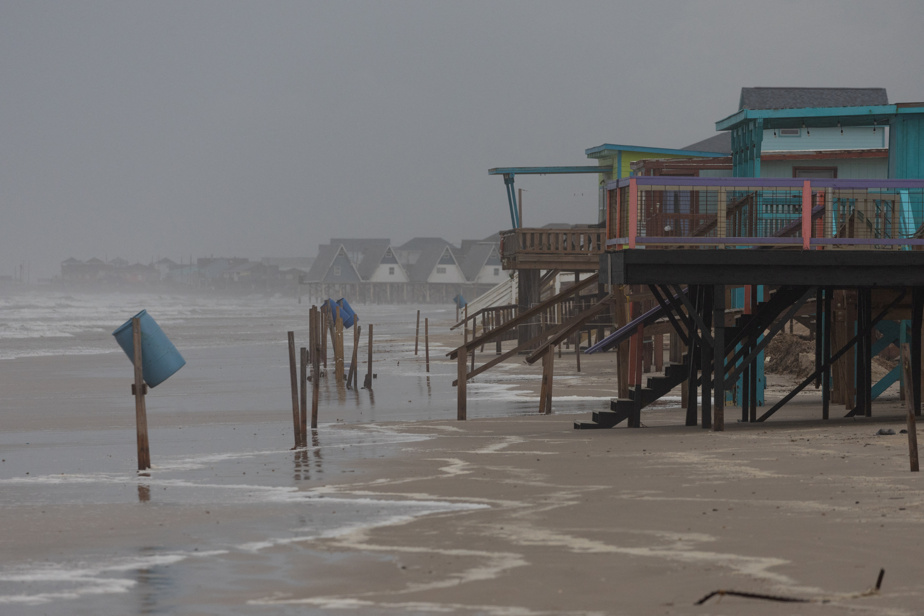(Matagorda) The tropical storm Beryl struck Texas on Monday, knocking out power to nearly 3 million homes and businesses and unleashing heavy rains that led to dozens of rescues. The fast-moving storm threatened to carve a difficult path through several other states in the coming days.
Texas state and local officials have warned that power restoration could take several days after Beryl landed on shore, knocked down 10 transmission lines and felled trees that destroyed power lines.
In a few hours, Beryl weakened to a tropical storm, much less powerful than the Category 5 giant that wreaked havoc across parts of Mexico and the Caribbean last weekend.
But the fast-moving storm’s winds and rains were still powerful enough to knock down hundreds of trees already teetering in waterlogged ground and strand dozens of cars on flooded roads.
As the storm moved inland, it continued to threaten to spawn tornadoes.
Power outages = blackout
“We have not been through severe conditions,” said Texas Lt. Gov. Dan Patrick, who is serving as acting governor while Gov. Greg Abbott is out of the country, warning that it would take “several days to restore power.”
Houston was hit hard, with CenterPoint Energy reporting more than 2 million homes and businesses without power in and around the nation’s fourth-largest city.
Mr. Patrick said the company was bringing in thousands of additional workers to restore power, with a top priority going to places like nursing homes and assisted living facilities.
At least two people were killed when trees fell on homes, and the National Hurricane Center said damaging winds and flash flooding would continue as Beryl is moving inland. A third person, a civilian employee of the Houston Police Department, was killed while trapped in floodwaters under a freeway overpass, Houston Mayor John Whitmire said. However, there were no immediate reports of widespread structural damage.

PHOTO ADREES LATIF, REUTERS ARCHIVES
Resident Josh Greenlee watches the hurricane swells Beryl at dusk from his electric scooter in Surfside Beach, Texas.
The power outage is an all-too-familiar experience in Houston: Powerful storms had just ravaged the region in May, killing eight people, leaving nearly a million without power and flooding many streets.
Houston and Harris County officials said power crews would be dispatched to the area to restore service as quickly as possible, an urgent priority for homes also left without air conditioning in the middle of summer. Temperatures, which had cooled slightly with the storm, were expected to rise again as early as Tuesday. The National Weather Service issued a heat advisory saying the region’s heat index could reach 105 degrees Fahrenheit.
The state will be prepared to open cooling centers as well as food and water distribution centers, said Nim Kidd, the state’s emergency operations chief.
Water rescues
The rains of Beryl storms hit Houston and other coastal areas Monday, shutting down streets in neighborhoods that had been battered by previous storms. Television stations broadcast the dramatic rescue Monday of a man who climbed onto the roof of his pickup truck after it became stuck in fast-moving water. Emergency crews used a fire truck’s extension ladder to put a life jacket and a tether on him before moving him to dry land.
Houston authorities reported at least 25 water rescues Monday afternoon, mostly of people whose vehicles were stuck in floodwaters.
“First responders put their lives on the line. That’s what they’re trained to do. It works,” Houston Mayor John Whitmire said.
Many streets and neighborhoods in Houston were littered with fallen branches and other debris. The hum of chainsaws filled the air Monday afternoon as residents went to work cutting down toppled trees and large branches that blocked streets and sidewalks.
Flaring
Several companies with refineries or industrial facilities in the region reported that the power outages required the flaring of gas at their facilities.
Marathon Petroleum Corp. said it conducted a “safe burn-off of excess gas” at its Galveston Bay refinery in Texas City, but did not provide information on how much gas was flared or for how long. Formosa Plastics Corporation and Freeport LNG also reported flaring related to Berylaccording to the Texas Commission on Environmental Quality (TCEQ).
Companies have 24 hours to share their emissions data after flaring stops, a TCEQ representative said in an email.
First storm to strengthen into a Category 5 hurricane in the Atlantic, Beryl caused at least 11 deaths as it passed over the Caribbean en route to Texas. The storm ripped off doors, windows and roofs, accompanied by devastating winds and a storm surge fueled by record Atlantic heat.
In Louisiana
In Louisiana, heavy rain bands were expected throughout the day Monday and “the potential for precipitation and flash flooding will be elevated,” National Weather Service meteorologist Donald Jones said during a Facebook Live briefing Monday morning.
The Shreveport Weather Service issued tornado warnings for northwest Louisiana. The agency confirmed on social media that several tornadoes had been spotted in that part of the state. Information on whether the weather events caused significant damage was not immediately available.
Beryl was expected to bring rain and stronger winds to other states in the coming days. One of them, Missouri, was already in the grip of a wet summer. Heavy rains unrelated to the storm triggered several water rescues around the city of Columbia, where rivers and streams were already high before the expected arrival of Beryl Tuesday.
